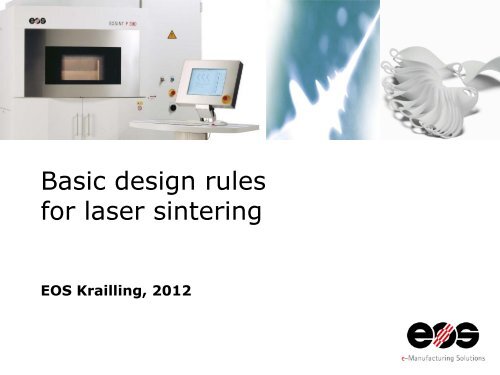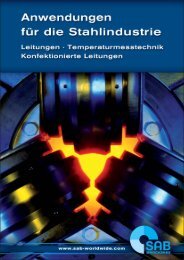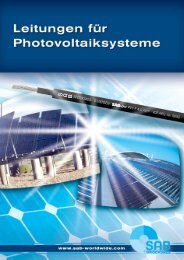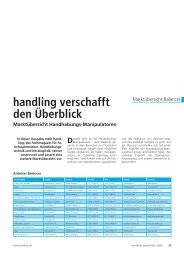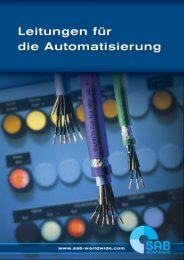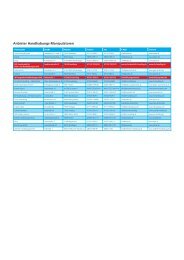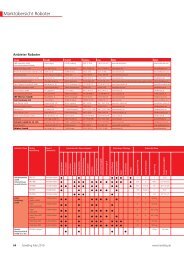Basic design rules for laser sintering - Handling
Basic design rules for laser sintering - Handling
Basic design rules for laser sintering - Handling
Create successful ePaper yourself
Turn your PDF publications into a flip-book with our unique Google optimized e-Paper software.
<strong>Basic</strong> <strong>design</strong> <strong>rules</strong><br />
<strong>for</strong> <strong>laser</strong> <strong>sintering</strong><br />
EOS Krailling, 2012
Useful links <strong>for</strong> EOS machines, materials and<br />
material properties<br />
— Overview of machines http://www.eos.info/produkte/systeme-zubehoer.html<br />
— Overview of materials http://www.eos.info/produkte/werkstoffe.html<br />
— Material properties <strong>for</strong> Plastics http://eos.materialdatacenter.com/eo/<br />
EOS 2012 · <strong>Basic</strong> Design <strong>rules</strong> <strong>for</strong> <strong>laser</strong> <strong>sintering</strong> Page 2
Building Chamber<br />
— Formiga P100<br />
• 200 x 250 x 330 Standard<br />
• 190 x 240 x 330 <strong>for</strong> PrimePart DC<br />
— Eosint P390<br />
• 340 x 340 x 620 Standard<br />
• 310 x 310 x 620 PrimePart DC<br />
• 290 x 290 x 290 PA 2202 black<br />
— Eosint P730<br />
• 700 x 380 x 580<br />
— Attention: Building Chamber = Part + Scaling !!!!!<br />
• The possible part size is depending on the scaling factor<br />
• scaling of 3.2 means a possible part size of 329 mm in x direction<br />
• It is not possible to build a 340 x 340 x 620 mm part <strong>for</strong> P390 !<br />
Source: EOS GmbH<br />
EOS 2012 · <strong>Basic</strong> Design <strong>rules</strong> <strong>for</strong> <strong>laser</strong> <strong>sintering</strong> Page 3
Coordinates<br />
Z<br />
— X direction of recoater<br />
— Z direction of plat<strong>for</strong>m<br />
Z<br />
Y<br />
Y<br />
X<br />
X<br />
offene<br />
prozeskammer bild<br />
Machine P730<br />
Process chamber P390<br />
Source: EOS GmbH<br />
EOS 2012 · <strong>Basic</strong> Design <strong>rules</strong> <strong>for</strong> <strong>laser</strong> <strong>sintering</strong> Page 4
Steps<br />
— if a plane is in an angle to the x-y area you have under an angle of 20 ° steps on your<br />
surface<br />
— visibility and size depending on layerthickness<br />
Z<br />
>20°<br />
Y/X<br />
Source: EOS GmbH<br />
EOS 2012 · <strong>Basic</strong> Design <strong>rules</strong> <strong>for</strong> <strong>laser</strong> <strong>sintering</strong> Page 5
Hinges<br />
— Gaps (A) <strong>for</strong> Hinges:<br />
• x/y: 0.3 mm - 0.5 mm<br />
• z: 0.5 mm - 0.6 mm<br />
— Variables:<br />
• Gap between bush and bolt (A)<br />
• length of the hinge (B)<br />
• diameter of the bolt (C)<br />
• thickness of the surrounding<br />
bushing (D)<br />
• Building direction<br />
— smaller gap possible with advanced<br />
geometrie training <strong>design</strong> <strong>rules</strong><br />
Source: EOS GmbH<br />
EOS 2012 · <strong>Basic</strong> Design <strong>rules</strong> <strong>for</strong> <strong>laser</strong> <strong>sintering</strong> Page 6
Font<br />
— minimum font size 14<br />
suitable <strong>for</strong> every direction<br />
— smaller fonts possible but it<br />
depends on:<br />
• building direction<br />
• inside / depth of font<br />
• outside / height of font<br />
Test part <strong>for</strong> visibility of fonts<br />
Source: EOS GmbH<br />
EOS 2012 · <strong>Basic</strong> Design <strong>rules</strong> <strong>for</strong> <strong>laser</strong> <strong>sintering</strong> Page 7
tolerances in parts<br />
— depending on the fact that we build exact<br />
the same part as in the cad-system<br />
<strong>design</strong>ed it is necessary to change your<br />
measurements to an symmetric tolerance<br />
zone.<br />
— the bad example has a unsymmetrical<br />
tolerance zone the good one a symmetric.<br />
— in the sinter process it is only possible to<br />
build with symmetric tolerances<br />
Source: EOS GmbH<br />
EOS 2012 · <strong>Basic</strong> Design <strong>rules</strong> <strong>for</strong> <strong>laser</strong> <strong>sintering</strong> Page 8
lose connection<br />
— use 0.1 mm distance<br />
<strong>for</strong> lose connection<br />
— a mal and female<br />
part without a gap<br />
have a press fit<br />
— only <strong>for</strong> parts not<br />
built together! else<br />
see hinges.<br />
Source: EOS GmbH<br />
EOS 2012 · <strong>Basic</strong> Design <strong>rules</strong> <strong>for</strong> <strong>laser</strong> <strong>sintering</strong> Page 9
walls / pins<br />
walls<br />
— X/Y<br />
• min possible wall thickness = 0.7 mm <strong>for</strong> P390 /P730<br />
• min possible wall thickness = 0.45 mm <strong>for</strong> P100<br />
• min wall thickness <strong>for</strong> reproducible measurements and mechanical properties = 1.5 mm<br />
— Z<br />
• min possible wall thickness = one Layer; typical 0.15 <strong>for</strong> P390 and 0.10 <strong>for</strong> Formiga<br />
pins<br />
— min pin thickness = 0.8 mm<br />
— min pin thickness <strong>for</strong> reproducible measurement and mechanical properties = 1.8 mm<br />
Source: EOS GmbH<br />
EOS 2012 · <strong>Basic</strong> Design <strong>rules</strong> <strong>for</strong> <strong>laser</strong> <strong>sintering</strong> Page 10
gap<br />
— the min size of a gap is depending on the wall thickness of the part<br />
Gap width [mm]:<br />
0.5<br />
0.6<br />
0.7<br />
y<br />
0.8<br />
Wall thickness:<br />
x<br />
0.30mm 3.00mm 6.00mm<br />
Source: EOS GmbH<br />
EOS 2012 · <strong>Basic</strong> Design <strong>rules</strong> <strong>for</strong> <strong>laser</strong> <strong>sintering</strong> Page 11
hole<br />
— possible min hole diameter is depending on the thickness of wall<br />
Hole diameter:<br />
0.5mm<br />
0.6mm<br />
0.7mm<br />
y<br />
Source: EOS GmbH<br />
0.8mm<br />
x<br />
Wall thickness: 0.30mm 0.60mm<br />
EOS 2012 · <strong>Basic</strong> Design <strong>rules</strong> <strong>for</strong> <strong>laser</strong> <strong>sintering</strong> Page 12
costs<br />
— costs depending on z- height (machine hours) and part volume<br />
(powder)<br />
— reducing z-height<br />
• <strong>design</strong> parts as low as possible in Z<br />
• stackable => increase filling rate<br />
bad example<br />
good example<br />
— reducing part volume<br />
• integrated <strong>design</strong><br />
• lightweight <strong>design</strong><br />
• <strong>for</strong>ce flow optimized <strong>design</strong><br />
Source: EOS GmbH<br />
EOS 2012 · <strong>Basic</strong> Design <strong>rules</strong> <strong>for</strong> <strong>laser</strong> <strong>sintering</strong> Page 13
powder removable <strong>design</strong><br />
— powder must be removable<br />
• problems in small long pipes<br />
• very complex parts with inside structure<br />
• the example is easy to produce but in the long<br />
hollow pipe inside it is impossible to remove the<br />
whole powder ( pic2 grey). With compressed air<br />
is it possible to clean one or two windings but<br />
the rest remains inside.<br />
example part<br />
— if the powder is removable very simple your post<br />
processing time is shorter<br />
example transparent<br />
Source: EOS GmbH<br />
EOS 2012 · <strong>Basic</strong> Design <strong>rules</strong> <strong>for</strong> <strong>laser</strong> <strong>sintering</strong> Page 14
Data <strong>for</strong>mat<br />
— the interchange <strong>for</strong>mat <strong>for</strong> RP technologies is<br />
STL<br />
— the file describe a surface by triangles<br />
— the file size and detail resolution is<br />
depending on the number of triangles<br />
— square-cut surfaces are easy to describe<br />
exact pic1. For free<strong>for</strong>m or round shaped<br />
parts you need a lot of triangles pic 2+3<br />
— a guide value <strong>for</strong> plastic parts is:<br />
• deviation tolerance: 0.01 mm<br />
• angle tolerance: 2 deg<br />
rough triangulation | fine triangulation<br />
Source: EOS GmbH<br />
EOS 2012 · <strong>Basic</strong> Design <strong>rules</strong> <strong>for</strong> <strong>laser</strong> <strong>sintering</strong> Page 15
www.eos.info


